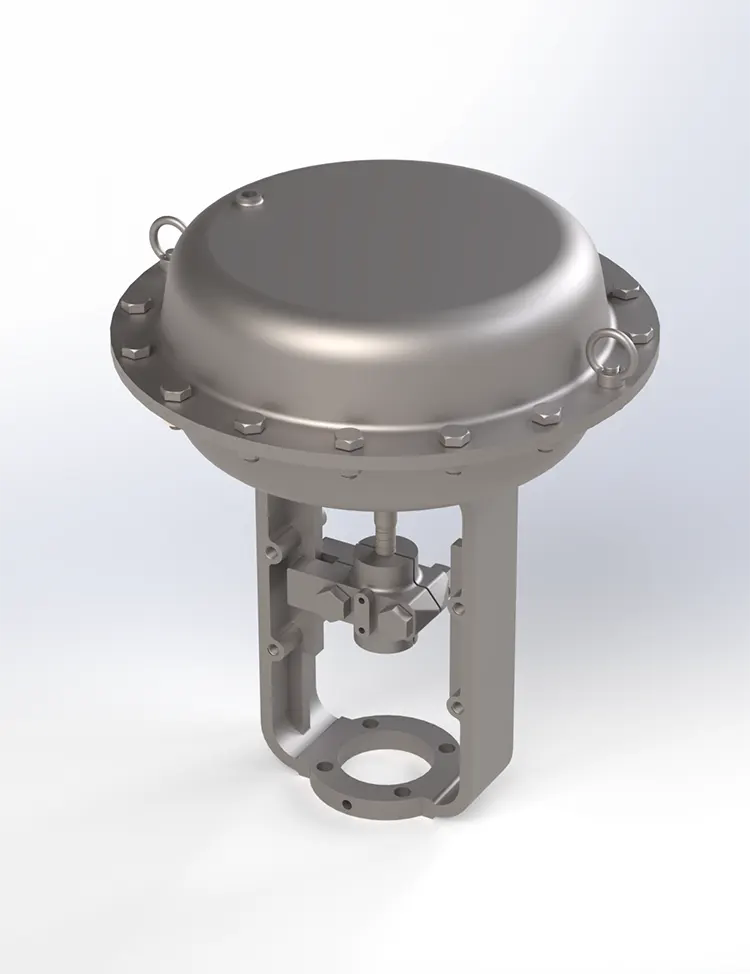In industrial automation, the seamless operation of valves relies heavily on reliable actuation systems. Among the various actuation technologies available, pneumatic diaphragm actuators stand out for their simplicity, durability, and cost-effectiveness. But how exactly do these devices work, and what makes them a preferred choice in countless industrial applications? This comprehensive guide will explore the mechanics, key features, product parameters, and common questions surrounding pneumatic diaphragm actuators, shedding light on their critical role in modern industrial processes.
Understanding the Mechanics of Pneumatic Diaphragm Actuators
At their core, pneumatic diaphragm actuators convert compressed air energy into linear motion to operate valves. The design revolves around a flexible diaphragm that separates two chambers within the actuator housing. When compressed air is introduced into one chamber, it creates a pressure differential that pushes or pulls the diaphragm, which is connected to a stem. This stem, in turn, links to the valve, causing it to open, close, or modulate its position based on the air pressure applied.
One of the defining characteristics of pneumatic diaphragm actuators is their spring - return mechanism. In single - acting models, the diaphragm is paired with a spring. When air pressure is applied, it overcomes the spring force to move the valve stem; when the pressure is released, the spring returns the stem to its original position. This feature is particularly valuable in emergency situations, as it ensures the valve can return to a fail - safe position (either fully open or closed) if air supply is lost.
Double - acting pneumatic diaphragm actuators, on the other hand, utilize compressed air in both chambers. Air pressure is alternately applied to each side of the diaphragm to drive the stem in both directions, eliminating the need for a strong return spring. This design offers greater thrust output and is often chosen for larger valves or applications requiring more precise control over valve movement.
Key Advantages in Industrial Applications
Pneumatic diaphragm actuators have earned their place in diverse industries due to a range of inherent advantages. Their simplicity is a major plus—with fewer moving parts compared to electric or hydraulic actuators, they are less prone to mechanical failure and easier to maintain. This simplicity also translates to lower initial costs, making them an economical choice for many operations.
Durability is another standout feature. Constructed with robust materials such as aluminum, cast iron, or stainless steel for the housing, and high - quality elastomers (like EPDM, nitrile, or PTFE) for the diaphragm, these actuators can withstand harsh industrial environments. They resist corrosion, high temperatures, and exposure to various chemicals, ensuring reliable performance in settings such as chemical processing plants, wastewater treatment facilities, and oil refineries.
Speed of response is yet another benefit. Pneumatic diaphragm actuators can quickly adjust valve positions in response to changes in air pressure, making them suitable for applications where rapid process adjustments are necessary. This responsiveness helps maintain process stability and efficiency, reducing the risk of costly downtime or product quality issues.

Product Parameters
Essential Specifications
-
Single - acting (spring - return) – available in both fail - open and fail - closed configurations.
-
Double - acting – requires air pressure for both opening and closing movements.
-
Pressure Range: Typically 30 - 150 psi (2 - 10 bar), with some models capable of handling up to 200 psi (14 bar) for high - thrust applications.
-
Air Quality: Requires clean, dry compressed air (filtered to 5 microns, with a maximum dew point of 10°C below the minimum operating temperature) to prevent diaphragm damage and ensure longevity.
-
Materials of Construction:
-
Housing: Aluminum (lightweight, cost - effective), cast iron (high strength), stainless steel (corrosion resistance for harsh environments).
-
Diaphragm: EPDM (excellent for general use, resistant to water and steam), nitrile (good for oil and fuel applications), PTFE (chemically inert, ideal for aggressive chemicals).
-
Stem: Stainless steel (304 or 316) for corrosion resistance and strength.
-
Standard models: -20°C to +80°C (-4°F to +176°F).
-
High - temperature models: Up to +150°C (+302°F) with specialized diaphragm materials.
-
Low - temperature models: Down to -40°C (-40°F) with cold - resistant elastomers.
-
Suitable for globe valves, gate valves, butterfly valves, and plug valves.
-
Available in various sizes to match valve stem diameters, typically ranging from 1/2 inch to 12 inches.
Performance Metrics Table
|
Parameter
|
Single - Acting Model (Example)
|
Double - Acting Model (Example)
|
|
Maximum Thrust Output
|
500 - 5,000 lbf
|
1,000 - 10,000 lbf
|
|
Stroke Length
|
0.5 - 4 inches
|
0.5 - 6 inches
|
|
Response Time
|
< 1 second (for 90% stroke)
|
< 0.8 seconds (for 90% stroke)
|
|
Operating Efficiency
|
> 85%
|
> 90%
|
|
Cycle Life
|
> 1 million cycles
|
> 1.5 million cycles
|
Applications Across Industries
The versatility of pneumatic diaphragm actuators makes them indispensable in a wide array of industrial sectors. In the chemical processing industry, they are used to control the flow of corrosive chemicals through pipelines. Their corrosion - resistant materials and precise actuation ensure that valve movements are accurate, preventing leaks and maintaining the integrity of chemical reactions.
In water and wastewater treatment plants, these actuators play a key role in regulating the flow of water, sludge, and chemicals. They are used in applications such as controlling the flow into filtration systems, adjusting the dosage of treatment chemicals, and managing the discharge of treated water. Their ability to operate reliably in wet and humid environments makes them a natural fit for this sector.
The oil and gas industry also relies heavily on pneumatic diaphragm actuators. They are used in upstream operations (such as wellhead control), midstream (pipeline transportation), and downstream (refining processes). In these applications, they must withstand high pressures and potentially explosive environments, which is why many models are available with ATEX or IECEx certifications for hazardous areas.
Other notable applications include power generation, where they control the flow of steam and cooling water in power plants; food and beverage production, where their easy - to - clean design and compatibility with food - grade materials ensure compliance with hygiene standards; and pharmaceutical manufacturing, where precision and reliability are critical to maintaining product quality and meeting regulatory requirements.
Pneumatic Diaphragm Actuators FAQ
Q: How often should the diaphragm in a pneumatic diaphragm actuator be replaced?
A: The diaphragm is a wear component, and its lifespan depends on factors such as operating temperature, the type of fluid or gas in the environment, and the frequency of actuation cycles. In standard operating conditions (temperatures between -20°C and +80°C, clean air supply, and moderate cycle rates), the diaphragm typically lasts 1 - 3 years. In harsh environments (high temperatures, exposure to chemicals, or frequent cycling), replacement may be needed every 6 - 12 months. Regular inspection is key—look for signs of cracking, tearing, or degradation. If leaks are detected around the diaphragm or if actuation becomes less precise, it’s time to replace the diaphragm. Using high - quality replacement diaphragms made from compatible materials is essential to ensure optimal performance and prevent premature failure.
Q: Can pneumatic diaphragm actuators be used with control systems for automated operation?
A: Yes, pneumatic diaphragm actuators are easily integrable with various control systems for automated operation. They are commonly paired with valve positioners, which receive electrical signals (typically 4 - 20 mA) from a process controller and convert them into corresponding air pressure signals to drive the actuator. This allows for precise modulation of valve position based on process variables such as flow, pressure, or temperature. Additionally, many modern actuators can be equipped with feedback devices (such as position sensors) that send real - time position data back to the control system, enabling closed - loop control and remote monitoring. This integration makes them suitable for use in distributed control systems (DCS) and supervisory control and data acquisition (SCADA) systems, enhancing automation and process efficiency.
When it comes to high - quality pneumatic diaphragm actuators,
Zhejiang Lozose Intelligent Control Instrument Co., Ltd is a trusted provider. Our actuators are engineered with precision, using top - grade materials to ensure durability, reliability, and optimal performance in even the most demanding industrial environments. Whether you need single - acting or double - acting models, standard or specialized configurations, we have the solutions to meet your specific application requirements.
If you're looking to enhance your industrial valve control systems with reliable pneumatic diaphragm actuators, or if you have any questions about our products and services, please don't hesitate to
contact us. Our team of experts is ready to assist you with personalized advice and support to help you find the perfect solution for your needs.



